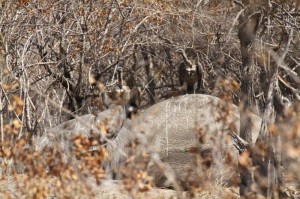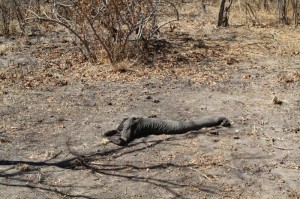I received this letter and asked its writer Paul Lavender whether I might print it along with his name and photographs. It is not often one gets this window on elephant poaching from a hunter’s perspective, and it is heartbreaking. Keep in mind that Tanzania, which led the original push for an ivory ban, has just petitioned CITES to sell over 100 tonnes of ivory, the latest break in the ivory ban. Thank you, Paul: 
[Dear Bryan,]
I read your excellent piece in Nat Geo, and wanted to tell you of our recent experience in Tanzania. Last August my wife and I were buffalo hunting on a block in Rungwa, fairly smug in our certainty that we were helping to support conservation of endangered species, and wildlife in general. 2nd day out we heard sustained automatic weapons fire not more than a km away. We could hear several weapons and there was initial fire of 80-100 rounds.
Our PH [professional hunter] was clearly outraged, but was calm and assured us the gunfire was from poachers who would do what they had come to do and leave us alone; the gunfire had ceased so we accepted the PH’s assurances, though we were shocked that poaching could happen on a private block, and were conscious that a PH had been killed by elephant poachers the previous year in the area. When the gunfire started again we ran for the truck and got out of there.
The PH had already rung the game commissioner on a sat phone who couldn’t do anything because he was new and “didn’t know the area”; calls were made to the safari company’s head office, and strings were pulled. The result was that a bunch of rangers in new land cruisers turned up at our camp that evening and promised to visit the kill site next day. It was unclear why they had come to our camp, which was some distance from the kill site.
The PH asked if we were willing to go to the kill site the next day. We were, and we’re horrified to find 11 dead elephants; mothers, babies, immature males. The poachers had clearly killed the whole herd irrespective of whether they had ivory or not. I took a lot of photos.The trackers looked around and confirmed there had been 8-10 poachers, 4 shooters; and that they were all on bicycles. The tyre tracks from the bicycles were clearly visible. We had been about 800m from the site the previous day when the poachers opened fire.The trackers could see no vehicle tracks from the rangers, who were supposed to have visited that morning. There was one small village in a 30 mile radius, so it didn’t ring true that the poachers could easily evade the authorities. Yet they did.
We looked around for a couple of days and easily found 3 more recent kills. The PH had been active in the area for several years and was horrified by the volume of kills, which he said was unprecedented and worried him that there would be no elephants left in Tanzania in a few years. He was also worried at the comparatively small number of elephant sightings during our safari.
We got cut off from camp by a bush fire, about 12 km from camp, the next night: it was thought initially that poachers had started the fire , but later we were told it was the safari company’s employees (which sounded a bit unlikely given neither the PH nor camp staff expected it).The next morning we were told by one of the trackers that the Rangers were raiding a shebeen where the poachers were on a drinking binge. It seemed probable that if we knew about this raid, that the poachers would as well, and sure enough a Ranger told us the next day that the raid had been unsuccessful; the poachers had gone elsewhere to drink.
Our driver had seen 2 poachers on bicycles with 2 large plastic containers on the back of each leaving the village; he was in no doubt they were carrying ivory.
The senior area game commissioner insisted on visiting me in camp a few days later; I believe this was a PR exercise but it rather misfired. A well dressed and accessorised and charming man, he assured me that elephant poaching in the area was unusual, and generally the few kills were on a small scale. He also confirmed that his department was taking strong and decisive action against the poachers all of whom it had already identified, and that it had already conducted a successful raid against the poachers who carried out the main attack (which we knew to be untrue). He also told us that one poacher at the main site had been killed by the elephants , and another seriously injured who was in hospital and would be arrested when well enough. Our tracker laughed when I asked him if this was true: he was adamant that no one had been killed or injured at the site, only elephants.The commissioner became somewhat less charming when I argued that the way Tanzania allocated the hunting blocks to safari companies for only 2 years discouraged investment, and encouraged corruption; that poaching is facilitated by the fact that, unlike Namibia and South Africa, game animals have no ownership. He got particularly prickly when I suggested that the very considerable revenue generated by the government from leasing out hunting blocks, and from trophy fees, was not all ending up being used for conservation.Thankfully I had to cut that pointless conversation short to get the truck to the airstrip, but it left a bad taste in the mouth and had the opposite effect to that intended.
We were deeply upset by the whole experience, it ruined the trip of a lifetime and has given us doubts over the “hunters protect wildlife” argument. Worst of all we doubt there will be any elephants left in Tanzania for our grandchildren to see.Best regards,
Paul Lavender


